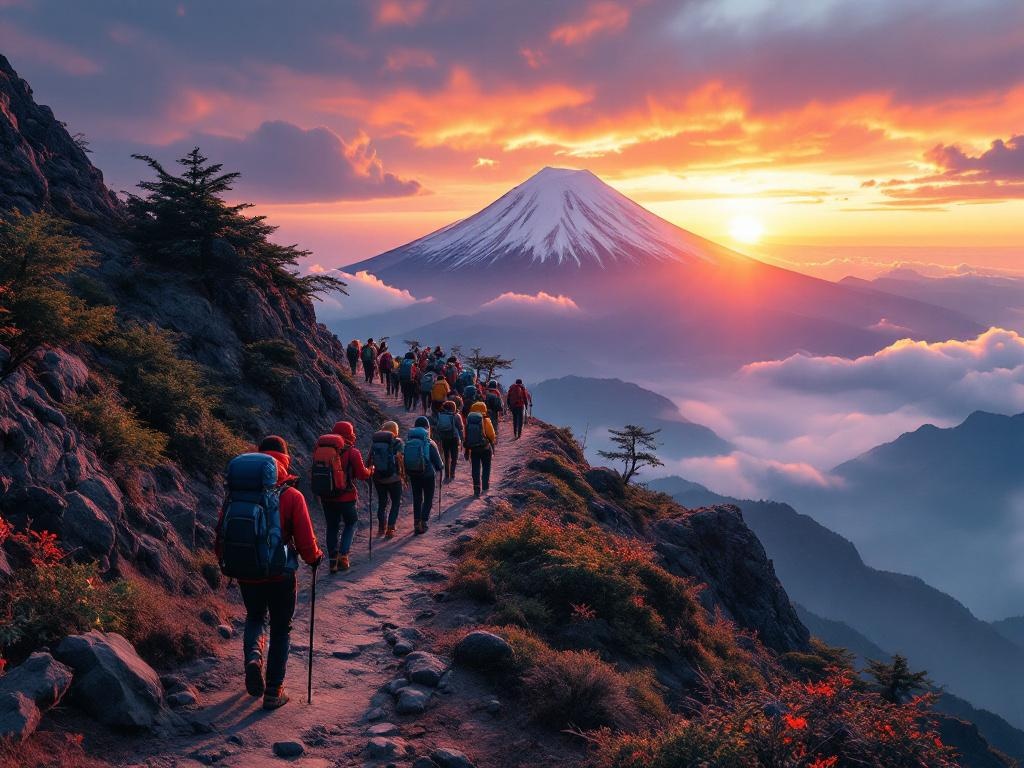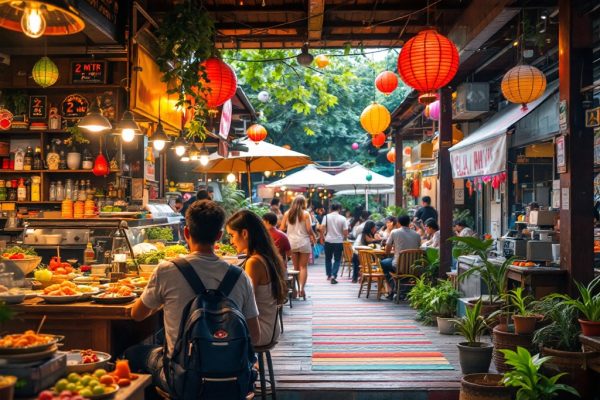Climbing Mount Fuji in Japan
Conquer Japan’s highest peak! Mount Fuji, a 3,776-meter UNESCO World Heritage site, awaits your ascent. Choose from various trails, like the popular Yoshida or challenging Fujinomiya, during the official climbing season (July to early September). Prepare for breathtaking views, but also rapid weather changes. Learn about essential gear, altitude sickness precautions, and the unique experience of witnessing *goraikō*, the sunrise from the summit. Plan your unforgettable Mount Fuji adventure now!
Important information

- Mount Fuji, Japan’s highest point at 3,776 meters, is climbable during the official season (early July to mid-September).
- Climbers must make online reservations and pay a fee of ¥4,000.
- Rapid weather changes are common, requiring layered clothing, rain gear, and a headlamp.
- Altitude sickness is a risk; acclimatization and hydration are crucial.
- Four main trails exist, each offering unique challenges and scenery, with Yoshida Trail being the most popular for beginners.
Introduction to Climbing Mount Fuji
Scaling Mount Fuji is an unforgettable adventure. Standing at 3,776.24 meters, this majestic stratovolcano is Japan’s highest point and holds deep cultural significance, drawing countless climbers annually. While the ascent is challenging, it’s definitely achievable with adequate preparation. The breathtaking views from the summit make the effort worthwhile. However, the mountain’s weather can shift rapidly, so careful planning is essential. Respect Fuji’s power, and remember the climb is a journey, not a race. Take your time and savor the surrounding beauty. Before you travel, make sure you have the necessary visa or permits. Check the latest entry requirements here: Find out entry rules for your destination
Why Climb Japan’s Highest Mountain?
Ascending Mount Fuji, Japan’s majestic 3,776-meter peak, offers a rewarding blend of adventure and spiritual reflection. The climb, while moderately challenging, is achievable for most with adequate preparation. The stunning views from the summit make the effort truly worthwhile. This unique cultural experience provides an unforgettable perspective of Japan’s natural beauty and spiritual heritage.
Mount Fuji as a UNESCO World Heritage Site
Mount Fuji, designated a UNESCO World Heritage site in 2013, holds undeniable cultural and artistic significance. For centuries, this revered peak has been a sacred site, inspiring countless artists and poets. Its remarkable geology, shaped by volcanic activity, and the surrounding landscape further cement its status as a true global treasure.
Planning Your Climb
The prime climbing season typically spans from July to early September. However, confirming specific dates beforehand is crucial, as regulations and reservation requirements can change. You may need reservations during peak periods, and admission fees often apply. Thorough research and advance booking will ensure a smooth climb.
Official Climbing Season and Regulations
The official climbing season is from early July to mid-September, offering well-maintained trails and facilities. Climbing outside this period is strongly discouraged due to hazardous conditions and lack of trail maintenance. Snow and ice accumulation can make off-season climbing extremely dangerous.
Online Reservations and Admission Fee
Hikers are required to make online reservations for all trails at a fee of ¥4,000 per person.
Choosing Your Trail
Less experienced climbers often choose the Yoshida Trail. It offers numerous huts and a gentler incline, although it can become crowded.
Experienced hikers seeking solitude will appreciate the Gotemba Trail. This is the longest route, offering unique volcanic vistas.
For a challenging but shorter ascent, the steep Fujinomiya Trail offers quicker summit access due to its proximity, but expect crowds.
The scenic Subashiri Trail winds through forests and volcanic terrain. It eventually merges with the Yoshida Trail near the summit, contributing to its congestion.
The Popular Yoshida Trail
The Yoshida Trail, Mount Fuji’s most popular ascent route, sees an impressive 4,000 hikers daily. Its accessibility and numerous mountain huts contribute to its widespread use.
The Steep Fujinomiya Trail
Looking for the quickest way to summit Mount Fuji? The Fujinomiya Trail is your shortest route. Be prepared for a steep, challenging climb, but the rewarding views make it worthwhile. Unlike the crowded Yoshida Trail, the Fujinomiya Trail offers a less congested ascent with breathtaking scenery. It’s a favorite among experienced mountaineers for its swift climb.
The Long Gotemba Trail
The Gotemba Trail, the longest of Mount Fuji’s four main ascents (Yoshida, Subashiri, Fujinomiya, and Gotemba), presents a unique challenge. Yet, it rewards hikers with breathtaking panoramic views.
The Subashiri Trail Experience
Experience the volcanic beauty of Mount Fuji on the unique Subashiri Trail, starting your ascent from the 5th Station on the northeastern slope. Unlike the Yoshida, Gotemba, and Fujinomiya routes, this path offers a different perspective. It leads hikers through a lush forest teeming with diverse plant and animal life. The terrain, composed of volcanic sand and ash, requires sturdy hiking boots with strong ankle support. The descent is much faster thanks to the loose volcanic material, following a separate, quicker route. The Subashiri Trail guarantees an unforgettable climb.
Preparing for the Climb
Preparing for a climb involves focusing on fitness, gear, and health. Climbers should maintain a reasonable level of fitness. Research indicates that proper preparation and pacing significantly contribute to successful climbs. Essential gear includes sturdy boots and layered clothing. This should include thermal wear, a waterproof jacket, gloves, and a hat. A headlamp is also crucial for visibility in low-light conditions. Pack essential supplies such as water, snacks, and a first-aid kit. Trekking poles can provide added stability and reduce strain on your joints. Altitude sickness is a serious health risk at higher elevations, so acclimatization is vital. Taking breaks and staying hydrated helps prevent altitude sickness. Understanding the terrain and checking weather forecasts is paramount for a safe climb. Mountain weather can change rapidly, so be prepared for all conditions.
Physical Fitness and Health Considerations
Climbing Mount Fuji is a challenging but rewarding adventure, requiring both physical and mental strength. The high altitude and rugged terrain demand stamina and endurance. Hiring a guide is recommended, especially for inexperienced hikers or those with health concerns, for a safer and more enjoyable climb. While strenuous, the climb offers breathtaking views.
Proper Equipment for a Safe Hike
Sturdy hiking boots are essential for conquering challenging trails, protecting your feet and providing excellent traction.
Dress in layers, starting with thermal wear and topping it off with a waterproof outer layer, allowing you to adapt to fluctuating weather conditions. Gloves and a hat provide additional warmth.
A headlamp is indispensable for night hikes or early morning ascents, illuminating the trail ahead. Pack ample water and snacks to maintain your energy levels. A first-aid kit is a necessity for any hike, as minor injuries can occur.
Trekking poles offer valuable support, particularly on steep inclines, reducing stress on your joints.
A fully charged phone is crucial in emergencies, serving as a lifeline if you become lost or injured, enabling you to call for help or utilize GPS.
Altitude Sickness Precautions
Ascend gradually to acclimatize to the higher elevation.
Hydration is key, so drink plenty of water.
Be vigilant for altitude sickness symptoms such as headaches, nausea, or dizziness.
Should these worsen, descend immediately.
Medication can be an option, but consult a doctor beforehand.
Prioritize rest and avoid overexertion.
Pace yourself throughout your climb.
During the Climb
Be prepared for unpredictable weather. Mount Fuji’s weather changes rapidly, so pack warm layers, waterproof gear (jacket and pants), and check the forecast before you climb.
Book mountain hut reservations in advance. Basic accommodations and food are available along the trails, but reservations are highly recommended, especially during peak season (July to early September).
Pace yourself during the climb. The summit climb is challenging due to altitude and steep terrain. The descent can be equally strenuous, especially on loose gravel sections.
Utilize first-aid stations if needed. First-aid stations are available along the Yoshida Trail to provide assistance during the descent.
Weather Conditions and Safety Measures
Climbing Mount Fuji requires careful preparation due to its unpredictable weather. Sudden changes in conditions can include rain, wind, fog, and temperature drops. Pack layered clothing, rain gear, and a headlamp. Hydration is key, so bring plenty of water. Regularly check weather forecasts before and during your climb.
Mountain Huts and Accommodation Options
Mountain huts on Mount Fuji offer essential amenities, including meals and sleeping quarters. Reservations are strongly recommended, especially during peak climbing season. These huts are crucial for climbers, providing a place to rest and acclimatize, which is essential for both ascending and descending the mountain.
The Ascent, Summit, and Descent
The ascent is mostly straightforward and doesn’t demand any specialized climbing skills.
From the summit, you’ll be rewarded with an incredible panoramic view.
While descending is technically simpler, the volcanic gravel can be tough on your knees.
Special Experiences and Tips
Experiencing sunrise from Mount Fuji’s summit, known as *goraikō* in Japanese, is truly unforgettable. While climbing solo offers freedom and a personal challenge, hiring a guide provides valuable expertise, especially for less experienced climbers, enhancing safety and offering insights into the mountain’s rich history and environment.
Climbing Mount Fuji: Solo vs. Guided
Solo Climbing: Offers freedom and a personal sense of accomplishment. Ideal for experienced climbers comfortable navigating independently. Requires self-sufficiency in terms of safety and navigation.
Guided Climbing: Provides valuable expertise and enhances safety, particularly for less experienced climbers. Offers insights into the mountain’s history, geology, and environment. Handles logistical aspects, allowing climbers to focus on the experience.
Preparation for Beginners and Families
Even beginners and families can enjoy the climb with adequate preparation. Building stamina through shorter hikes is highly recommended.
Yoshida Trail
Consider starting with less challenging trails like the Yoshida Trail to acclimatize and gain experience.
Essential Supplies
Pack ample water and snacks to maintain energy levels throughout the climb. Take frequent breaks to avoid exhaustion.
Climbing Mount Fuji does have inherent risks, including altitude sickness, unpredictable weather, and potential volcanic activity. Climbers should acclimatize to higher altitudes gradually. Be prepared for rapidly changing weather conditions. Pack appropriate gear, including warm layers, rain gear, and sturdy hiking boots. Stay informed about any volcanic warnings or advisories issued by authorities.
Witnessing the Sunrise from the Summit
Experiencing *Goraiko*, the sunrise from atop Mount Fuji, is an unforgettable experience. As the sun ascends, the sky erupts in vibrant hues, revealing a breathtaking panorama. Climbers who reach the summit discover a shrine and are imbued with a profound sense of achievement. However, due to often frigid temperatures at the peak, warm clothing is essential. This includes a thick jacket, gloves, and sturdy hiking boots.
Climbing Alone vs. Hiring a Guide
Planning a Mount Fuji climb? While the well-marked trails are suitable for solo ascents, consider the advantages of hiring a guide. Guides enhance your safety, offer valuable local insights, and handle all logistical details. For novice climbers, a guide is especially recommended. Climbing with a companion is another way to increase your safety on the mountain.
Family Hikes and Beginner Tips
Begin your climb on easier routes like the Yoshida Trail for effective acclimatization.
A gradual increase in altitude is crucial, so pack plenty of water and energy-boosting snacks.
Dress in layers to adapt to the rapidly changing mountain weather.
Take regular breaks to prevent exhaustion.
Supervise children closely.
Consider hiring a guide for enhanced safety and expert guidance.
Familiarize yourself with the symptoms of altitude sickness.
Aim to descend before nightfall, but reserve a mountain hut for a safe overnight stay if necessary.
Risks and Challenges of Climbing
Altitude sickness is a serious risk due to Mount Fuji’s high elevation.
Be prepared for rapid and drastic weather changes, packing gear for rain, wind, and freezing temperatures.
The climb is strenuous, with steep sections demanding significant physical strength.
Protect yourself from the intense sun at high altitude.
Thorough preparation and appropriate packing are essential for a safe and successful climb.












